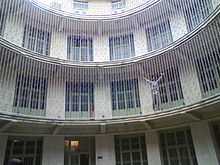Towhid Prison

Towhid Prison (in Persian: بازداشتگاه توحید) was an unofficial detention centre in Tehran, Iran, used against opponents of the Islamic Republic of Iran until its closure in 2000.[1] At its peak during the 1980s, it housed over 3,000 political prisoners, among the nearly 35,000 political prisoners imprisoned in the city of Tehran.[2]
Before 1979 it was known as Anti Vandalism Joint Committee, or Komiteh Moshtarak, and operated under the government of the Shah of Iran against political opponents. It was vastly expanded after the Islamic Revolution, and renamed Towhid Prison (The word towhid refers to one of the five pillars of Islam, monotheism). The majority of the prison's usage was under the Islamic Republic.[3][4]
It reportedly was shut down by the Islamic Republic in August 2000, after Roozbeh Farahanipour presented his report on the prison to Amnesty International and other human rights organizations.[5][6]
Coordinates: 35°41'13"N 51°25'7"E.
Currently it is Edification Museum (Ebrat Museum) of Tehran, putting abuses under the Shah (but not the Islamic Republic) under display. The prisoners on display are from a small pre-selected list to be commemorated.[7]
See also
References
- ↑ http://marzeporgohar.org/v2/index.php?l=1&cat=14&scat=&artid=31
- ↑ http://www.iran-bulletin.org/witness/ghaffar2.html
- ↑ http://www.iranrights.org/english/memorial-case-44464.php
- ↑ http://marzeporgohar.org/v2/index.php?l=1&cat=14&scat=&artid=31
- ↑ http://www.web.amnesty.org/web/ar2001.nsf/webmepcountries/IRAN?OpenDocument
- ↑ "CBC: The Fifth Estate - The Axis of Evil". Cbc.ca. Retrieved 2013-05-20.
- ↑ http://www.iranrights.org/english/memorial-case-44464.php
External links
| Wikimedia Commons has media related to Towhid Prison. |
- Official website
- Roozbeh Farahanipour's report on Towhid Prison
- Torture, Detention, and the Crushing of Dissent in Iran from Human Rights Watch
Coordinates: 35°41′13″N 51°25′07″E / 35.68694°N 51.41861°E